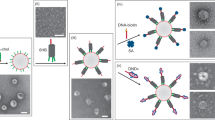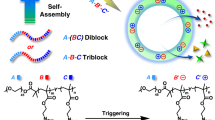Abstract
Polymeric vesicles are a relatively new class of nanoscale self-assembled materials that show great promise as robust encapsulants. Compared with liposomes, use of polymeric building blocks for membrane formation allows increased stability, stimuli responsiveness and chemical diversity, which may prove advantageous for drug-delivery applications 1. A major drawback of most polymeric vesicles is the lack of biofunctionality, which restricts their ability to interact with cells and tissues. We have prepared vesicles composed of polyarginine and polyleucine segments that are stable in media, can entrap water soluble species, and can be processed to different sizes and prepared in large quantities. The remarkable feature of these materials is that the polyarginine segments both direct structure for vesicle formation and provide functionality for efficient intracellular delivery of the vesicles. This unique synergy between nanoscale self-assembly and inherent peptide functionality provides a new approach for design of multifunctional materials for drug delivery.
This is a preview of subscription content, access via your institution
Access options
Subscribe to this journal
Receive 12 print issues and online access
$259.00 per year
only $21.58 per issue
Buy this article
- Purchase on Springer Link
- Instant access to full article PDF
Prices may be subject to local taxes which are calculated during checkout



Similar content being viewed by others
References
Discher, D. E. & Eisenberg, A. Polymer vesicles. Science 297, 967–973 (2002).
Holowka, E. P., Pochan, D. J. & Deming, T. J. Charged polypeptide vesicles with controllable diameter. J. Am. Chem. Soc. 127, 12423–12428 (2005).
Rothbard, J. B., Jessop, T. C. & Wender, P. A. Adaptive translocation: the role of hydrogen bonding and membrane potential in the uptake of guanidinium-rich transporters into cells. Adv. Drug Deliv. Rev. 57, 495–504 (2005).
Futaki, S. Membrane-permeable arginine-rich peptides and the translocation mechanisms. Adv. Drug Deliv. Rev. 57, 547–558 (2005).
Brooks, H., Lebleu, B. & Vivès, E. Tat peptide-mediated cellular delivery: back to basics. Adv. Drug Deliv. Rev. 57, 559–577 (2005).
Wadia, J. S. & Dowdy, S. F. Transmembrane delivery of protein and peptide drugs by TAT-mediated transduction in the treatment of cancer. Adv. Drug Deliv. Rev. 57, 579–596 (2005).
Calnan, B. J., Tidor, B., Biancalana, S., Hudson, D. & Frankel, A. D. Arginine-mediated RNA recognition: the arginine fork. Science 252, 1167–1171 (1991).
Mitchell, D. J., Kim, D. T., Steinman, L., Fathman, C. G. & Rothbard, J. B. Polyarginine enters cells more efficiently than other polycationic homopolymers. J. Peptide Res. 56, 318–325 (2000).
Rothbard, J. B. et al. Conjugation of arginine oligomers to cyclosporin A facilitates topical delivery and inhibition of inflammation. Nature Med. 6, 1253–1257 (2000).
Torchilin, V. P., Rammohan, R., Weissig, V. & Levchenko, T. S. TAT peptide on the surface of liposomes affords their efficient intracellular delivery even at low temperature and in the presence of metabolic inhibitors. Proc. Natl Acad. Sci. USA 98, 8786–8791 (2001).
Tseng, Y.-L., Liu, J.-J. & Hong, R.-L. Translocation of liposomes into cancer cells by cell-penetrating peptides penetratin and tat: A kinetic and efficacy study. Mol. Pharmacol. 62, 864–872 (2002).
Bermudez, H., Brannan, A. K., Hammer, D. A., Bates, F. S. & Discher, D. E. Molecular weight dependence of polymersome membrane structure, elasticity, and stability. Macromolecules 35, 8203–8208 (2002).
Rodriguez-Hernandez, J. & Lecommandoux, S. Reversible inside-out micellization of pH-responsive and water-soluble vesicles based on polypeptide diblock copolymers. J. Am. Chem. Soc. 127, 2026–2027 (2005).
Ranquin, A., Versees, W., Meier, W., Steyaert, J. & Van Gelder, P. Therapeutic nanoreactors: Combining chemistry and biology in a novel triblock copolymer drug delivery system. Nano Lett. 5, 2220–2224 (2005).
Deming, T. J. Facile synthesis of block copolypeptides of defined architecture. Nature 390, 386–389 (1997).
Discher, B. M., Hammer, D. A., Bates, F. S. & Discher, D. E. Polymer vesicles in various media. Curr. Opin. Colloid Interface Sci. 5, 125–145 (2000).
Sakai, N. & Matile, S. Anion-mediated transfer of polyarginine across liquid and bilayer membranes. J. Am. Chem. Soc. 125, 14348–14356 (2003).
Rothbard, J. B., Jessop, T. C., Lewis, R. S., Murray, B. A. & Wender, P. A. Role of membrane potential and hydrogen bonding in the mechanism of translocation of guanidinium-rich peptides into cells. J. Am. Chem. Soc. 126, 9506–9507 (2004).
Wadia, J. S., Stan, R. V. & Dowdy, S. F. Transducible TAT-HA fusogenic peptide enhances escape of TAT-fusion proteins after lipid raft macropinocytosis. Nature Med. 10, 310–315 (2004).
Mosmann, T. Rapid colorimetric assay for cellular growth and survival: Application to proliferation and cytotoxicity assays. J. Immunol. Methods 65, 55–63 (1983).
Pakstis, L., Ozbas, B., Nowak, A. P., Deming, T. J. & Pochan, D. J. The effect of chemistry and morphology on the biofunctionality of self-assembling diblock copolypeptide hydrogels. Biomacromolecules 5, 312–318 (2004).
Sela, M. & Katchalski, E. Biological properties of poly α-amino acids. Adv. Protein Chem. 14, 391–478 (1959).
Deming, T. J. Cobalt and iron initiators for the controlled polymerization of alpha-amino acid-N-carboxyanhydrides. Macromolecules 32, 4500–4502 (1999).
Acknowledgements
This work was supported by a grant from the National Science Foundation (CHE-0415275) to T.J.D. and by a Sidney Kimmel Scholar Award to D.T.K.
Author information
Authors and Affiliations
Contributions
E.P.H. and V.Z.S.: experimental work and data analysis; T.J.D. and D.T.K.: project planning, data analysis and manuscript writing.
Corresponding author
Ethics declarations
Competing interests
The authors declare no competing financial interests.
Supplementary information
Supplementary Information
Supplementary information and figures S1-S3 (PDF 185 kb)
Rights and permissions
About this article
Cite this article
Holowka, E., Sun, V., Kamei, D. et al. Polyarginine segments in block copolypeptides drive both vesicular assembly and intracellular delivery. Nature Mater 6, 52–57 (2007). https://doi.org/10.1038/nmat1794
Received:
Accepted:
Published:
Issue Date:
DOI: https://doi.org/10.1038/nmat1794
This article is cited by
-
Helical polymers for biological and medical applications
Nature Reviews Chemistry (2020)
-
Why does the Aβ peptide of Alzheimer share structural similarity with antimicrobial peptides?
Communications Biology (2020)
-
Catalytic processing in ruthenium-based polyoxometalate coacervate protocells
Nature Communications (2020)
-
Programmed assembly of synthetic protocells into thermoresponsive prototissues
Nature Materials (2018)
-
Small amphipathic peptides are responsible for the assembly of cruciferin nanoparticles
Scientific Reports (2017)



